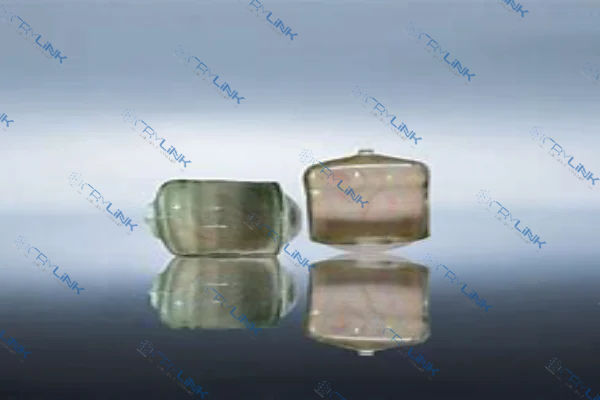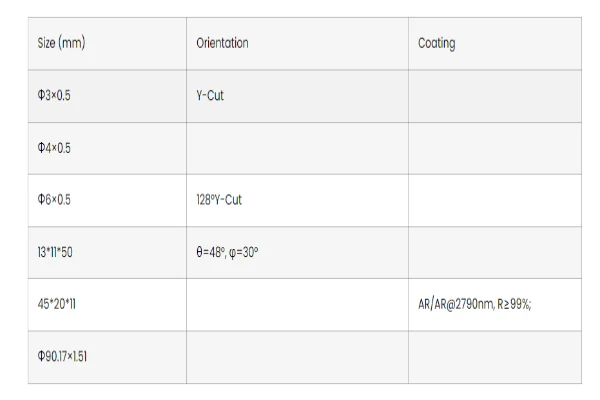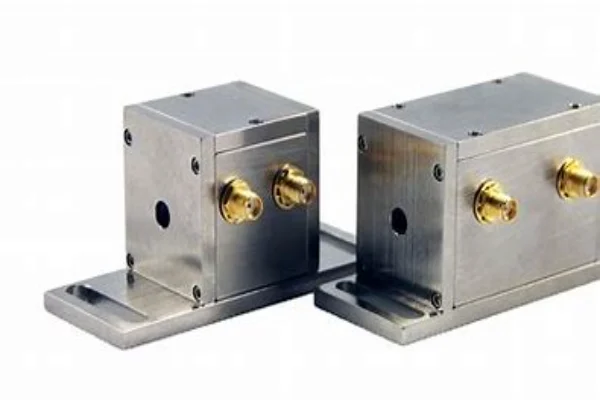Overview of LiNbO3 Crystal
Lithium niobate (LiNbO3) is a unique and versatile material known for its numerous photonic applications. Thanks to its exceptional electro-optic, nonlinear, and piezoelectric properties, it has found a special place in the world of optical modulators.

Essential Properties of LiNbO3 Crystal
Building on the fundamental properties of LiNbO3 crystals, we delve deeper into how these characteristics translate into real-world applications. To understand the multifaceted role of these crystals, we need to fully comprehend their essential properties, namely the electro-optic effects, nonlinear optical traits, and piezoelectric characteristics.
LiNbO3 crystals exhibit unparalleled electro-optic properties, placing them at the forefront of many photonic applications. The term ‘electro-optic’ describes the ability of a material to alter its optical properties in response to an electric field. When it comes to LiNbO3 crystals, the most significant change is seen in their refractive index – the measure of how much they can bend light.
As we apply an electric field to a LiNbO3 crystal, its refractive index varies, leading to changes in the phase velocity of light passing through it. This is a pivotal aspect in applications such as optical modulators, which control the intensity, phase, or polarization of light signals in optical communication systems. By exploiting these superior electro-optic effects, LiNbO3 crystals offer a gateway to high-speed, efficient, and versatile optical modulators.
Equally important are the nonlinear optical properties of LiNbO3 crystals. Nonlinear optics involves the interaction of light with matter in a manner that the response is nonlinear, leading to effects like frequency conversion. LiNbO3 crystals stand out in this domain due to their high optical damage threshold and exceptional nonlinearity. What’s intriguing is their ability to modify the frequency of light. In simpler terms, they can take light at one frequency and produce light at another frequency, a critical trait for advanced photonic applications. This becomes particularly crucial in technologies like laser systems, where a laser of one frequency can be transformed into a different frequency, paving the way for diversified applications spanning telecommunications, spectroscopy, medicine, and defense.

Lastly, the piezoelectricity exhibited by LiNbO3 crystals is nothing short of impressive. Piezoelectric materials can transform mechanical stress into an electric charge and vice versa. When mechanical stress is applied to a LiNbO3 crystal, it generates a voltage – an attribute that finds usage in pressure sensors, acoustic wave generators, and sonar devices. Conversely, when an electric field is applied, the crystal undergoes a shape or size change, making it a suitable choice for actuators and piezoelectric transducers.
In essence, these properties of LiNbO3 crystals provide an exciting platform for a multitude of applications, transcending the boundaries of traditional photonic materials. Their multifunctionality stems from their unique electro-optic, nonlinear, and piezoelectric traits, making them a truly versatile photonic marvel. The continued exploration of these properties will undoubtedly lead to the realization of more innovative applications and technologies in the years to come.

Role of LiNbO3 Crystal in Optical Modulation
When discussing the role of LiNbO3 crystal in optical modulation, it’s important to remember that this is a field where the control and manipulation of light are of paramount importance. Here, these crystals shine due to their unique properties, particularly their electro-optic effects.
One of the key applications of LiNbO3 crystals in optical modulation is phase modulation, a process that involves the manipulation of the phase of an optical signal. By harnessing the strong electro-optic coefficients of these crystals, we can change the light’s phase according to the electric field applied. This capability is essential in high-speed optical communication, where data is transmitted via the phase of light waves. In such applications, LiNbO3 crystals serve as an efficient and reliable medium for phase modulation.
But the role of LiNbO3 crystals doesn’t end at phase modulation. These crystals are equally significant in amplitude modulation, another key method of encoding information onto a light signal. Here, the strength or intensity of the signal is varied, again leveraging the electro-optic characteristics of LiNbO3 crystals. By controlling the amplitude of the light signal, LiNbO3 crystals provide a way to influence the overall performance of amplitude modulators, driving improvements in the quality of optical communication.
In addition, LiNbO3 crystals are indispensable in electro-optic switches, devices that control the direction of light in optical circuits. These switches work on the principle of the electro-optic effect, where the refractive index, and thus the direction of light, can be changed by an applied electric field. The fast response and high efficiency of LiNbO3 crystals make them a prime choice for such applications. Their ability to rapidly switch light paths in response to electric signals contributes significantly to the overall performance and speed of optical circuits.
In conclusion, LiNbO3 crystals, with their superior electro-optic characteristics, play a crucial role in modern photonics, particularly in optical modulation. Whether it’s phase modulation, amplitude modulation, or electro-optic switching, these crystals provide a versatile, efficient, and reliable solution, pushing the boundaries of what is possible in optical technology.
Advanced Applications of LiNbO3 Crystals
Beyond their pivotal role in optical modulators, the properties of LiNbO3 crystal enable their use in a wide array of advanced applications. Each characteristic of these crystals has been harnessed to create new possibilities in photonics, expanding their impact in various domains.
The nonlinear optical properties of LiNbO3 crystals, for instance, have made them a popular choice for frequency conversion devices. In these applications, the crystals act as a medium to alter the frequency of light, a process known as frequency conversion. This process is particularly important in laser technology, where it’s often necessary to convert the frequency of a laser to suit a specific application. It’s the unique nonlinear optical attributes of LiNbO3 crystals that make such conversions possible, and it’s what makes these crystals so invaluable to photonics.
But the applications of LiNbO3 crystals aren’t limited to optics. Thanks to their piezoelectric characteristics, these crystals have found significant use in the design and manufacture of transducers and actuators. As transducers, LiNbO3 crystals can convert electrical signals into mechanical vibrations, a transformation that is at the core of numerous scientific and industrial applications. When used as actuators, these crystals convert electrical energy into mechanical displacement, providing precise control in a variety of settings, from micro-positioning systems to aerospace engineering.
In essence, LiNbO3 crystals, thanks to their unique properties, have become a cornerstone in a wide range of applications. Be it optical modulators, frequency conversion devices, or piezoelectric transducers and actuators, the potential of these crystals is immense. And as our understanding of their properties deepens, we can expect to see even more advanced and innovative uses for these remarkable materials.

The Future of LiNbO3 Crystals in Photonics
As we look to the future of photonics, the role of LiNbO3 crystal is more significant than ever. Their unique electro-optic, nonlinear, and piezoelectric properties, combined with their adaptability and robustness, make them ideally suited for the development of next-generation optical devices. The continuous advancements in photonics and the pressing need for higher efficiency and speed in optical communication systems are likely to propel the demand for these crystals.
In the realm of optical modulation, the precise control of light properties provided by LiNbO3 crystals is something that current and future technologies will continue to exploit. As data transmission rates continue to soar, the need for efficient optical modulators will grow, and LiNbO3 crystals will be at the heart of these solutions.
Beyond modulation, the future holds immense promise for LiNbO3 crystals in the creation of more powerful and versatile frequency conversion devices. With their superior nonlinear optical properties, these crystals are poised to revolutionize laser technologies, pushing the limits of what is possible in photonics.
Furthermore, the piezoelectric properties of LiNbO3 crystal open up exciting opportunities in various scientific and industrial applications. As the demand for precise and efficient transducers and actuators grows, these crystals will be at the forefront, driving innovation in fields ranging from micro-electromechanical systems to aerospace engineering.
In conclusion, LiNbO3 crystals, with their unique properties and diverse applications, are set to play a pivotal role in shaping the future of photonics. They truly are a marvel of photonics, offering endless possibilities for innovation and advancement in the field.

Conclusion
From phase modulators to amplitude modulators, and electro-optic switches to frequency conversion devices, the use of LiNbO3 crystals in photonics is expansive and diverse. The unparalleled electro-optic and nonlinear optical traits of these crystals allow them to outshine in various applications, making them truly a marvel in photonics. As we continue to explore and understand these crystals better, they promise to revolutionize the realm of optical modulation and beyond.
FAQs
- 1. What are the key properties of LiNbO3 crystals?
- LiNbO3 crystals are known for their superior electro-optic, nonlinear, and piezoelectric properties. These attributes make them suitable for a range of photonics applications.
- 2. How do LiNbO3 crystals contribute to optical modulation?
- LiNbO3 crystals play a crucial role in optical modulation, including phase modulation, amplitude modulation, and electro-optic switches, due to their outstanding electro-optic characteristics.
- 3. What makes LiNbO3 crystals suitable for frequency conversion devices?
- The nonlinear optical traits of LiNbO3 crystals make them ideal for frequency conversion devices, as they can efficiently alter the frequency of light.
- 4. Can LiNbO3 crystals be used in transducers and actuators?
- Yes, the piezoelectric properties of LiNbO3 crystals allow them to convert electrical signals into mechanical vibrations and vice versa, making them suitable for transducers and actuators.
- 5. What is the future of LiNbO3 crystals in photonics?
- The unique attributes of LiNbO3 crystals and their potential for further innovation make them a promising material for the development of next-generation optical devices.

Frank
Frank graduated from the University of Shanghai for Science and Technology, majoring in optics. As a technical engineer at Crylink Company, he deeply understands crystal materials and laser components.
Related Video(s) with this Article
Related Product(s) with this Article
Related Application(s) with this Article
